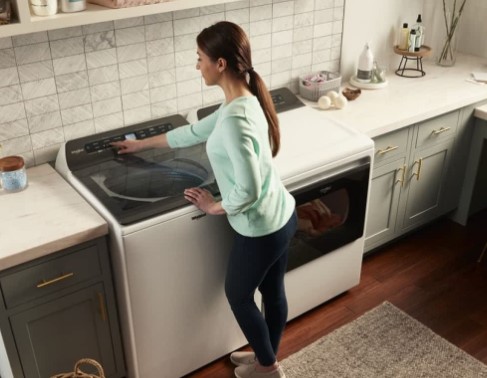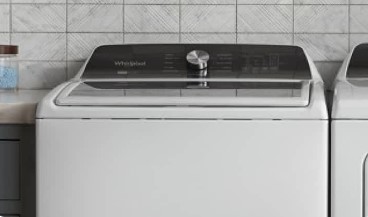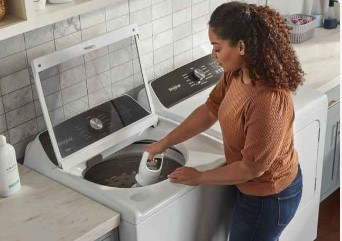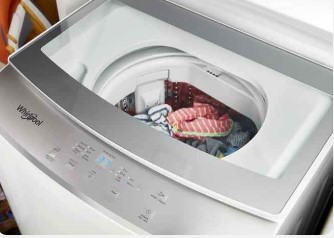Whirlpool washing machines go into a load-sensing phase for about 2-3 minutes to establish the load size and determine the correct amount of water to add to the load. Sometimes, however, you may face a Whirlpool washer stuck on sensing and can’t explain it.
Your Whirlpool washer may stay on sensing longer than usual due to a load imbalance, wrong wash setting, a faulty sensor, or a clogged drain. Other faults include a defective inlet valve, shift actuator, drive motor, or main control board.
This guide will explain the eight issues that could stop the Whirlpool washer from passing the sensing phase. More importantly, I’ll share how you can fix these issues and get your washer completing a cycle.
After that, I’ll walk you through other issues related to a malfunctioning Whirlpool washer. So, let’s jump in!

In a rush? Below is a table summary with the eight explanations why your Whirlpool washer won’t go beyond sensing.
Troubleshooting Manual to A Whirlpool Washer Stuck On Sensing
| – | Probable Cause | Fix |
| 1. | Load Imbalance | Rearrange the load evenly. In case of an overload, remove the extra clothes |
| 2. | Wrong Washer Setting | Reset your washer by disconnecting it from power for 3 – 5 minutes or more, then choose the correct setting |
| 3. | Clogged Drain | Clean the dirt or debris around the drainage system. |
| 4. | Faulty Sensor | Replace the sensor if faulty |
| 5. | Defective Inlet Valve | Replace the inlet valve if defective |
| 6. | Faulty Shift Actuator | Test the shift actuator continuity using a multimeter and replace it if faulty (lacks continuity) |
| 7. | Failing Drive Motor | Replace the motor if it’s old (over ten years), or consider buying a new one |
| 8. | Defective Control Board | Replace the control board if defective |
Why is My Whirlpool Washer Stuck On Sensing?
Below are the eight reasons why your Whirlpool washer sticks on sensing mode:
1. Load Imbalance
When your Whirlpool washer sticks on sensing mode, it does not necessarily mean that there’s a broken or defective part. At times it could be due to a load imbalance.
When the load is out of balance, your Whirlpool washer fails to run and may stay in sensing mode.
You can diagnose this by checking out if your washer is spinning. If the washer isn’t spinning, the issue could be a load imbalance.
Fix
Spread your laundry correctly before starting a wash cycle. If the washer is overloaded, remove some clothes and keep the maximum capacity ¾ full.
2. Wrong Washer Setting
If you fail to select a setting or pick the wrong one, you confuse your Whirlpool washer. When this happens, an error code may pop up, forcing the washer to remain in the sensing mode.
Fix
If an error occurs, reset your washer by unplugging it from power for 3 – 5 minutes before re-plugging it. If that won’t solve the issue, disconnect it for 15 – 20 minutes. But if the error clears, choose the right setting.
3. Faulty Sensor
A washer sensor tells a cycle to proceed to the next phase. If the sensor is faulty, your washer cannot advance to the subsequent cycle. In short, the control board that integrates all your washer functionality won’t receive any signal, and your washer gets stuck on sensing.
Fix
Reset your washer by performing a Whirlpool washer sensor reset, where you unplug it from power for 3 – 5 minutes before re-plugging it. If it’s faulty, replace it.

4. Clogged Drain
Your Whirlpool washer fails to go past sensing when the drain is clogged. This is because your washer harmoniously spins while draining the wastewater, which happens severally.
So, when the drain is clogged, there is a high chance that the washer won’t go beyond sensing mode.
Fix
Check if there’s dirt clogging in the supply line. In case of any, unclog it. But if the drain is faulty, replace it.
5. Defective Inlet Valve
The inlet valve comprises moving parts that control clean water flow to your washing machine.
When the water fills the drum, the inlet valve shuts, stopping water flow flowing in the drum. When the inlet valve is defective, the washer may take a long time to fill, and indeed, it won’t start but get stuck in sensing mode.
The slow filling of the washer shows either an electrical or mechanical failure. Mechanically, it could be due to corrosion or dirt around the inlet valve that hinders the valve from opening fully, delaying the filling process. Electrically, the valve fails if it doesn’t receive enough power or is damaged.
Fix
The bad news is that the inlet valve cannot be repaired. You will need to replace it whether it suffers electrical or mechanical damage.
6. Faulty Shift Actuator
The shift actuator is the component to check when your Whirlpool washer won’t go beyond sensing. It has an optical sensor that monitors the speed and position of the washer’s transmission.
The actuator may fail electrically and mechanically. You can tell that the actuator fails mechanically when one of its moving parts breaks. Electrically, the parts may face electrical faults due to a power surge or short circuit.
Fix
Unfortunately, once the shift actuator fails either mechanically or electrically, you must replace it. However, you should confirm its faultiness by testing its continuity using a multimeter. If it fails the test, replace it.
7. Failing Drive Motor
The drive motor is the heart of your washer. It receives power to initiate the spinning process. If the motor spins occasionally but won’t go beyond sense, then the motor is to blame.
Again, the motor may also suffer electrical damage or general wear, especially if your Whirlpool washer is old. When the motor fails, it prevents your Whirlpool washer from completing the sensing phase (2- 3 minutes) and advancing to the subsequent stages.
This is usually the case if you own an old Whirlpool washer. The motor may also fail if you overwork it with heavy loads or electrically in case of a power surge.
Fix
The motor is irreparable. Since it’s an expensive part, you need to check it carefully by testing it with a multimeter. In most cases, the motor has a lifespan of 10 years.
So if your washer is old, and the motor fails to function optimally, you should consider getting a new washer instead of replacing the motor.

8. Defective Control Board
If you check all the above but your Whirlpool washer won’t still go past sense, your last resort should be to check the control board.
The control board is the brain of your washer. It has a printed circuit board (PCB) comprising many components controlling different functions.
If the control board is faulty, your washer will get stuck in sensing mode.
Fix
It’s possible to repair any affected part of the PCB if you have the technicality needed. However, if the control board has a say on why your washer doesn’t go past sensing, you should replace it.
Whirlpool Washer Reset
If your washer didn’t go past sensing even after trying all the above, it would be an intelligent move to reset it. Below are three reset techniques to consider.
a) Power Cycling Technique
In the power cycling technique, you disconnect your whirlpool washer from power, wait 5 minutes, and then plug it back in. Note, however, that this only solves minor issues. If your washer has any electrical or mechanical problems proceed to the below reset methods.
b) Recalibration Technique
If your washer sticks on sensing, this reset method will help solve most issues like error codes. The downside is that it’s not available on all whirlpool washers.
- Below are the easy steps to follow:
- Turn the cycle selector knob anticlockwise
- Then turn it clockwise three times
- Take another turn anticlockwise and clockwise one more time
Remember that there should be half a second-time interval in every clock. Failure to which your Whirlpool washer won’t reset.
c) Entering Diagnostic Mode
It’s advisable to enter diagnostic mode when your washer gets stuck in sensing mode. This helps you diagnose the error and the defective part. Below are the simple steps to put your Whirlpool washer into diagnostic mode:
- Begin by turning the cycle selector knob to 360 degrees
- Then tilt it to the left one time
- Turn it three times to the right
- Lastly, a click to the left and one more turn to the right
Once done, all the LEDs will start blinking, and when this happens, you should press start for the washer to enter into the diagnostic. Also, remember that there should be a 1 ⁄ 2 second time interval between every click.
Whirlpool Duet Washer Stuck On Sensing
Your Whirlpool Duet washer won’t go past sensing mode due to the following:
- Load imbalance
- Wrong washer setting
- Defective inlet valve
- Faulty sensor
- Defective shift actuator
- Faulty control board
- Failing motor

Whirlpool Cabrio Washer Stuck On Sensing
Just like any other Whirlpool washer, your Cabrio washer gets stuck on sensing mode due to the following:
- Load imbalance
- Wrong setting
- A clogged drain
- Defective control board
- Faulty drive motor
- Defective inlet valve
- Failing shift actuator
People Also Ask
1. Why Is My Whirlpool Washer Stuck On Sensing?
Your Whirlpool washer gets stuck on sensing mode due to a load imbalance, wrong washer cycle selection, faulty intel valve, or a clogged drain.
The issue could be a faulty drive motor, detective control board, or shift actuator if it’s neither.
2. How Long Does a Whirlpool Washer Stay On Sensing?
Your Whirlpool washer should stay in sensing mode for 2 – 3 minutes. This is enough time for it to determine the load size, water level, and latched door. However, if the time exceeds 3 – 5 minutes, there’s something amiss with your washer.
3. How Should I Get My Washer Out of Sensing?
It’s easy to get out of sensing mode. You must choose the correct setting, clean the drain system and rearrange the load evenly.
If the issue concerns a defective component like a shift actuator, sensor, motor, control board, or intel valve, replace the faulty part.
Concluding Thought On Whirlpool Washer Stuck On Sensing:
In conclusion, your Whirlpool washer gets stuck on sensing mode due to a clogged drain, load imbalance, or wrong cycle selection. It could also be due to a failing motor, defective control board, wrong washer setting, faulty sensor, defective intel valve, or faulty shift actuator. The good news is that all eight issues are DIY fixable, and the above is a guide to use.
Also Read;
